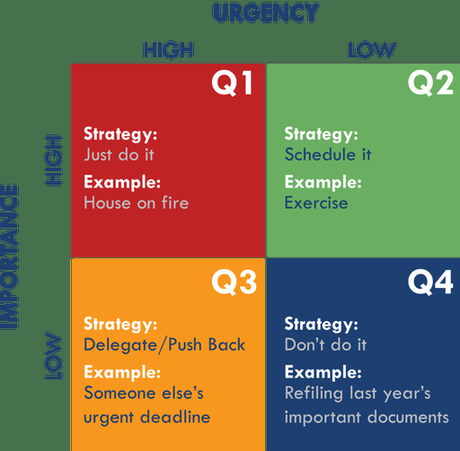The Eisenhower Method, also referred as Eisenhower Matrix or Urgent-Important Matrix, is an excellent time management tool and it helps you in deciding which action you should or shouldn’t do. It’s a wonderful tool by which you can prioritize tasks by its importance and its urgency, at the same time separate out less urgent and important tasks which you should either delegate or not do at all. It assists you to divide all actions and put them into one of four categories of matrix. The matrix is divided in to quadrants based on importance and urgency.

“What is important is seldom urgent and what is urgent is seldom important.”
~ Dwight D. Eisenhower
Who was Eisenhower?
Dwight D. Eisenhower was the 34th President of the United States of America from 1953 to 1961. Before becoming President, He was the American general in the United States Army, who invaded France when occupied by the Germans in the Second World War. He commanded over 2 million soldiers and was forced to find a better way to manage them. This requirement led him to design the one of the most important time management tool – Eisenhower matrix, which today helps you to prioritize the tasks by its importance and urgency.
How to Use the Eisenhower Method
Eisenhower Method is a useful time management tool for getting things done. Using the Eisenhower quadrant is very simple and easy. You just need to pick an item from your to-do list and you ask yourself following two questions.
Question no. 1 – “Is it urgent?”
Question no. 2 – “Is it important?”
You can now put the action into the correct quadrant.

Q1 – Urgent and Important
Examples:
- Medical Emergencies
- Deadlines
- Troubleshooting
These are important as well as urgent. You have to work on all these tasks. All these are important and help you to progress towards your goals; however, since they’re urgent, they’re often unplanned and unwanted.
You will always need to spend some time here, since emergencies will always occur. When they occur, you have to deal with them immediately. There will be no excuses. Once you have dealt with the situation, please spend time to make sure that it never will happen again or diminish its occurrence or make preparations in advance for future occurrence.
Ex: When cooking, make sure you have all the ingredients before starting, because you don’t want to be running to the grocery shop to buy some salt or other spices, when you’re in between the process of cooking food.
Q2 – Not Urgent and Important
Examples:
- Building quality relationships with other people
- Doing actual work to progress towards an important goal
- Physical exercise for good physical health
- Meditation for good mental health
This is the quadrant in which you should spent most of your time. Most people however, don’t do this and spent most of their time in any of the other quadrants. Because these important tasks don’t scream to you like a ringing phone, they’re often neglected in favor of more urgent matters.
If you spend very less or almost no time here, then your first important task should be to save some time each day to work on the important things. One thing you can do is to develop a system to avoid the urgent tasks. For example, if you do a lot of troubleshooting on your project. Spend time to fix errors beforehand to decrease the time cleaning up after the errors.
Q3 – Urgent and Not Important
Examples:
- Answering e-mails
- Incoming phone calls
- Interrupting colleagues
I recommend not spending time here either. Since the tasks are still not important and you’re still not progressing towards your goals. However, these tasks are urgent, therefore you can’t schedule them. They’re also difficult to ignore, since urgent action are often in front of your face and demand you quick attention. Ex: A phone call or an interrupting colleague.
You need to find a way to deal with these as quickly as possible. One way is to decrease the chance of other people disturbing you. You can do this by putting up a do not disturb or busy sign on your door. In spite of that, if they get past the busy sign and disturb, you need to handle their disturbances quickly. Be bold and say up front that you’re very busy and ask them to state their business quickly. It’s useless to just send them away, since they have already succeeded in disturbing you. You might as well listen to their request and note it down. As soon as you know why they disturbed you, send them away to continue working on the important stuff.
Q4 – Not Urgent and Not Important
Examples:
- Time wasters (Ex: Facebook, whatsapp, checking e-mails all the time…)
- Work that doesn’t need to be done)
- Procrastinating
You should not spend any time on activities in this quadrant. Anything which doesn’t help you in any way to progress towards your goals, it is not important. If it doesn’t help you to progress towards your goals, then why should you spend valuable time in doing it?
When is something not urgent? Anything if, it doesn’t matter when it is completed, then it’s not urgent. It can be done today, or it can be done next week or even next year, it doesn’t matter.
The combination of less or not urgent and less or not important is the poorest quadrant to spend your time in. Decrease your time in this quadrant and put it in some other. I prefer you put it in ‘not urgent and important’.
Summary of the Eisenhower Method
Not urgent and not important: Give least priority or don’t do these at all, if you spend most of the time here, stop doing it and start spending time in the ‘not urgent and important’ quadrant.
Urgent and not important: Always try to avoid these as much as possible. When you’re interrupted, handle it as quickly as possible.
Urgent and important: As these are urgent as well as important tasks, do these on priority , but when done, spend time to think about how to deal with the situation in the future.
Not urgent and important: Though not urgent, all your available time should go to this quadrant.
You can make a goal of spending at least 80% of your time in the ‘Not urgent and important’ quadrant. The other 20% will be divided between ‘urgent and important’ and ‘urgent and not important’.
Always use the Eisenhower method when adding items to your to-do list. Always ask yourself whether it is important and whether it is urgent.
If you have liked this article, please share it at your favorite social networks.
Thank you for reading this. Please add your valuable comments, they are much appreciated.
